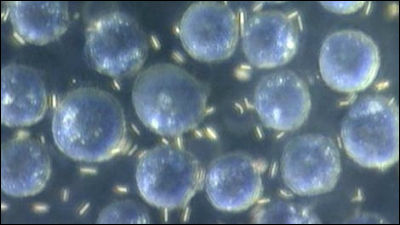'The world's smallest crab-shaped robot' with a total length of only 0.5 mm is born, and a video that moves sideways is also being released

Small robots have various possibilities such as exploring places that humans cannot enter and performing practical tasks. A new research team at Northwestern University in the United States has developed 'the world's smallest crab-shaped robot with a total length of only 0.5 mm.' A video of a robot walking sideways and moving around is also released.
Submillimeter-scale multimaterial terrestrial robots
Tiny robotic crab is smallest-ever remote-controlled walking robot --Northwestern Now
https://news.northwestern.edu/stories/2022/05/tiny-robotic-crab-is-smallest-ever-remote-controlled-walking-robot/
A research team led by John Rogers , a professor of materials engineering at Northwestern University, and Yonggang Huang , a professor of mechanical engineering, has developed a tiny crab-shaped robot with a total length of only 0.5 mm. You can see how the crab-shaped robot actually made by the research team moves in the following video.
Tiny robotic crab is smallest-ever remote-controlled walking robot --YouTube
The ultra-small crab-shaped robot developed this time is shown in the lower left and upper right of the screen. It firmly has 8 legs and 2 arms.

Each robot can vibrate and move slowly sideways.

It's smaller than a flea, and it's even possible to ride on the side of a coin.

Crab-shaped robots do not move by complicated hardware or hydraulic / electrical mechanisms, but by using the characteristics of the materials that make up the main body. The robot's body is made of a

'The structure of the robots is so small that the cooling rate is very fast. In fact, you can make them run faster by reducing their size,' Rogers said. 'It's difficult for a land-based robot to achieve this small size,' Huang added, saying that the robot he developed can travel about half the length in a second.

The research team adopted the '

When the rubber substrate loosens, the robot attached to the surface bends and becomes a three-dimensional shape so that it 'pops up'. Rogers explained why the research team dared to focus on crab-shaped robots, saying, 'Students were inspired by the sideways movement of small crabs and were amused. This is creative. It was capricious. '

'Robot engineering is an exciting research area, and microscale robot development is an academically enjoyable subject,' Rogers said. Microrobots repair and assemble small structures and machines in the industrial field. In addition to being used for this purpose, he claimed that it could be used in the medical field to clear blockages in obstructed arteries, stop internal bleeding, and assist in surgical operations to remove cancer tumors.
Related Posts:







